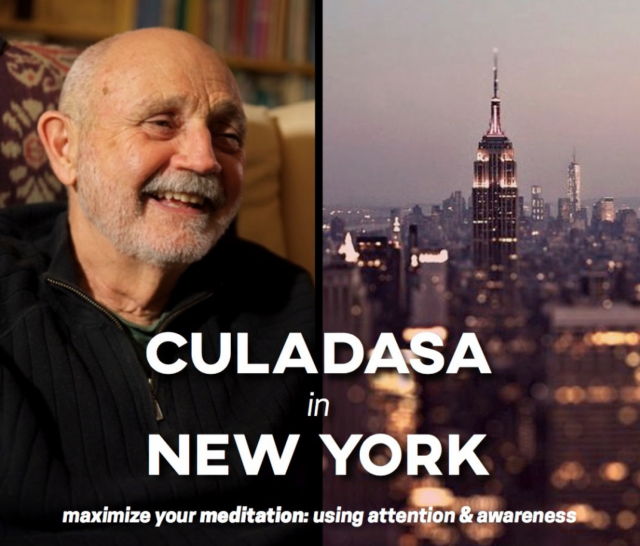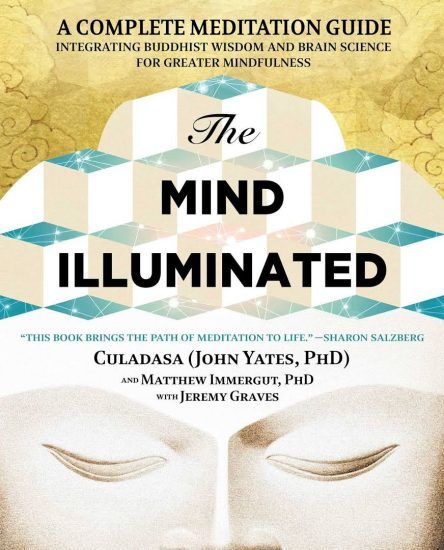
LIGHT ON MEDITATION — THE SCIENCE OF MEDITATIVE SUCCESS
Tibet House
22 West Fifteenth St. between Fifth & Sixth Aves.
Wednesday, January 25, free with advance RSVP, 7:00
212-807-0563
tibethouse.us
themindilluminated.com
MASTER CULADASA: LIGHT ON MEDITATION
The Three Jewels
61 Fourth Ave. between Ninth & Tenth Sts.
Saturday, January 28, $45 suggested admission, 2:00
212-475-6650
mindbodyonline.com
culadasa.com
THE MIND ILLUMINATED BOOK LAUNCH: MAXIMIZE YOUR MEDITATION — A ROADMAP TO MEDITATIVE SUCCESS
The Path at Primary
26 Broadway, eighth floor
Tuesday, January 31, $24, 7:00
www.thepath.com
www.simonandschuster.com
The combination of Buddhism and neuroscience is a heady one, as it were, and there’s no dearth of investigators and writers helping us understand our brain and our mind. Writers on the subject, from the Dalai Lama to Mingyur Rinpoche to B. Alan Wallace to Robert Thurman, have talked about the overlap between discoveries about consciousness in neuroscience and millennia-old Buddhist teachings on consciousness, the self, and reality. One of the latest authors working with these insights, John Yates, PhD (aka Culadasa), will be in New York City this month presenting his fascinating five-hundred-plus-page work, The Mind Illuminated: A Complete Meditation Guide Integrating Buddhist Wisdom and Brain Science for Greater Mindfulness (Simon & Schuster, January 2017, $25.99), written with Matthew Immergut, PhD, and Jeremy Graves. Dr. Yates, the director of the Dharma Treasure Buddhist Sangha in Tucson, studied deeply and intensively with both Theravadin and Tibetan Buddhist teachers and is a former professor of neuroscience. Prior to coming to New York City for three special events on January 25 (discussion, Q&A, and book signing at Tibet House), 28 (lecture, Q&A, and signing at the Three Jewels), and 31 (meditation and meal at the Path), he was happy to answer questions from a longtime twi-ny editor and meditator about his work and long-awaited first book.
twi-ny: The Mind Illuminated presents meditation as an everyday, evidence-based training activity for the mind that really works. If a reader sits down and practices with the first instructions in your book for six months, what results could they expect?
Culadasa: There is some variation, of course, but if a meditator diligently follows the instruction in a daily practice, they should achieve at least Stage Four — stable, continuous attention on the meditation object without episodes of forgetting or mind wandering. At this stage, our meditator can do something very few people can ever do: They can keep their attention focused on a chosen object, regardless of the intrinsic interest of the object, for very long periods of up to an hour. But even more importantly, they can simultaneously sustain a broad, open awareness of everything around them and of what is going on in their own mind as well. This allows them to begin observing and investigating their mind, which is a rich and wonderful experience. Some meditators will achieve higher stages: five, six, perhaps even seven. This is especially true of those who have been meditating according to some other method for a long time.

twi-ny: Now that the book is complete and published, out in the world, do you see your own teaching practice developing around it? What’s next?
Culadasa: Now that the book is available to a wider audience, I am finding a lot of people and organizations asking for my time. Due to my age and health, it’s simply impossible for me to respond to these requests. So over the last three years, I have been intensively training a brilliant group of people who will have a deep understanding of everything in the book and more. They will take over from me, so no, I don’t see myself building my teaching around it. I’ll be doing that initially, as I am now, but the baton will soon be passed to a younger generation.
As for myself, I am currently working on another book, one that I consider potentially even more important than The Mind Illuminated. I am hoping to present the Dharma to the world in terms that are understandable and acceptable to people everywhere, regardless of their religious affiliations or lack thereof. It is a book that I hope will transform the attitudes of people toward each other, and the dominant global culture, in time for us to save ourselves from ourselves.
twi-ny: As a meditation student and teacher myself, I appreciate the secular, neuroscience-based approach because it makes meditation available to so many who won’t try older styles of meditation training due to aversion to Eastern religion or “woo-woo.” But like many others, I’m skeptical that meditation training divorced from ethical training can actually be transformative. And ethics, whether religion-based or secular, is a very loaded subject. How would you explain your approach to this in the book?
Culadasa: You are absolutely right. Meditation divorced from the practice of virtue is quite limited in value and can only very rarely be transformative. But the West, and global culture in general, is fascinated by technology. Meditation is a kind of technology, so it’s a great way of getting people interested in the Dharma, and can make them aware of how much more it has to offer than just stress reduction, increased productivity, and better relationships. The practice of virtue in the Buddha’s teaching goes far beyond ethics. It is a powerful method in itself, contributing enormously to the arising of Insight and to the Awakening we all seek. The Eightfold Path has three parts: Wisdom, Virtue, and Meditation. They mutually support each other, and no one or even two of them can ever stand for long by itself. That is part of the reason I am working on my new book. It will provide the other two legs of the tripod.